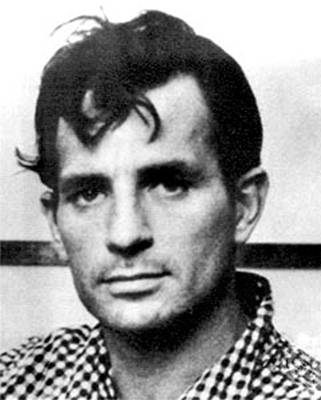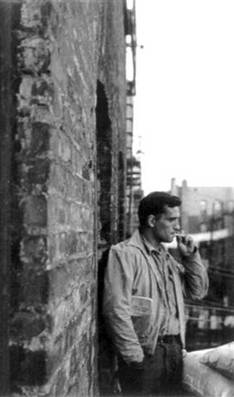|
By Patrick Fenton
“That’s
right. That’s right, Neal kept saying and all the time he was only concerned
with locking the trunk and putting the proper things in the compartment and
sweeping the floor and getting all ready for the purity of the road again,
the purity of moving and getting somewhere, no matter where, and as fast as
possible. We roared off. Neal pushed the Hudson through the Lincoln Tunnel and we were in New Jersey. It was drizzling and mysterious at the
beginning of our voyage. I could see that it was going to be one big saga of
the mist. ‘Here we go! ‘yelled Neal. And he gunned
her.”
(Jack Kerouac. “On the Road.”)
For a long time the original
manuscript that those words were written on remained in an old vault in
Kerouac’s agent’s office, Sterling Lord. In the 80’s his books weren’t
selling that well, and for awhile it looked like his time had come and gone.
The manuscript of “On the Road” was a large, cumbersome, scroll that took up
room. No one in the book publishing industry had ever seen anything like it
before. It was 120 feet long, one long paragraph written on tracing paper
taped together by Jack Kerouac so that he could feed it into his typewriter.
It’s a wonder that over the years it remained in the safe, that no one had
ever thrown it out.
In
November, this original manuscript of “On the Road,“ the actual 120 foot
scroll, will be on exhibit at the New York Public Library. Jack
Kerouac died on October 21, 1969, 47 years old, broke. Then after his death, there
was a long, dry period where little was written about him. His estate was
worth just a few hundred bucks, if that, and his
books stopped selling. Then, like a dam breaking, it seemed that every other
year a new biography would be out about him.
On May 22, 2001, the scroll was auctioned off at Christie’s in New York City. Jim Irsay, the owner of the Indianapolis Colts
bought it for almost two and a half million dollars. There have been volumes
of books and essays written on Jack Kerouac, but still, after a long period
he has remained one of the most misunderstood, underrated writers of our
time. Surprisingly, with all the attention paid to him, a definitive
biography of his life still hasn’t been written.
And now, on the 50th Anniversary of the publication of “On the
Road,” “the writers and critics who prophesize with their pens” are back
taking another shot at him, even though the book has been published in 32
languages and sells 100,000 copies a year according to its publisher, Viking
Penguin. Recently they released a 50th anniversary edition of it
along with the manuscript of the original scroll that he wrote it on,
published in book form for the first time, and a companion book, titled “Why
Kerouac Matters” by New York Times reporter, John LeLand.
In the beginning, there
were only a few who recognized Kerouac’s great literary talent as an American
novelist. Gilbert Milstein of the New York Times was the first when in his
review of the book he said, “there are sections of ‘On the Road’ in which the
writing is of a beauty almost breathtaking.“
After that one review in the New York Times in 1957, fame came to him
overnight. But he wasn’t comfortable with it. He was lost somewhere between
the innocence of those first promising, early days when he signed his books
“John Kerouac”, and the awful hurt that comes so often with literary success
in America.
He tried to hide out in the suburbs of Northport, Long Island, drinking his fill of whiskey and beer every
night with the local clam diggers who hung out in Peter Gunther’s Bar on Main Street. They say when winter came to that harbor town;
you would always find him hunched over a table at the back of the bar next to
the warmth of a kerosene heater. Eventually, in the fall of 1964 he fled even
further, down to St.
Petersburg Florida with his aging mother who always took care of
him.
For a while, he tried to go home again to his hometown, Lowell Massachusetts, and then eventually he headed back South to St. Petersburg. Then on February 3, 1968, his protagonist for “On the Road”, Neal
Cassady, his old road buddy, died. Before his death, which happened along the
railroad tracks after an afternoon of drinking at a wedding in San Miguel, Mexico, he had started telling friends that he was
tired of being Keroassady.
After that, Jack Kerouac spent most of his days and nights drinking whiskey
out of an aspirin bottle and recording his own voice as he talked to a black
and white television with the sound off. The few times that he made it into
town by cab, he was beaten badly in bar fights. Some nights he would be
dragged through the crowd by his pants belt by one of the bar regulars who
recognized him. And they would yell over the din of Saturday night bar band
music — listen up — listen up — this here guy is Jack Kerouac, the guy who
wrote “On the Road.” By then he was so red faced and fat, his belly bulging
out from a hernia, which he held in place with a silver dollar, nobody would
believe him. And as old John Mellencamp might say, “ain’t that America.“
Even now, as America and the World
celebrates the 50th anniversary of the writing of this American
classic, there are still some naysayers who write that “On the Road” is an
outdated book that the present generation of young people find little to
identify with.
But they are wrong. The very core of “On the Road” is in its beautiful,
sensitive descriptions of America, and the idea that once you could get lost in
its vastness for a while as you were growing up. The actor, Nick Nolte, once
said that after reading “On The Road“ in high school
in Omaha, “I remember thinking, ‘you can just do that?
Pick up and go?’ It seemed incredible to me.’”
In this world of Google and text messaging, I’m not too sure that is possible
anymore, even if young people are willing to get up from their computer
screens for a while and get on a Greyhound, or behind the wheel of a car.
That is what makes “On the Road “important. It once happened in America.
The one biographer
who always understood this is the noted historian Douglas Brinkley, the
author of “Jack Kerouac, Windblown World,” a collection of his journals. He
understood that Jack Kerouac was writing about America in a way that had not been done before, through the view of a rear view mirror of a car stirring up road
dust as it drove through a sleepy American town at 3 in the morning doing
over 90 mile an hour.
“He
was opening up the West in his writing to a new degree,” Brinkley recently
said during an interview with the Library of America. “Certainly Mark Twain
wrote about the West as did Jack London, Bret Harte, and Frank Norris. It
wasn’t new terrain but Kerouac brought modernity to it. He brought the
automobile into the West as a kind of spiritual playground where you can
travel at whim and find freedom. If you got a tank of gas you could go
anywhere in any direction at any time.”
Listen
for a moment to the ghosts of old Sal Paradise, and Dean Moriarty; still out
there somewhere in a lost America.
“’Well yes, well yes, and now I think we better be cutting along because we
gotta be in Chicago by tomorrow night and we already wasted several hours’….
I turned to watch the kitchen light recede in the sea of night. Then I leaned
ahead. In no time at all we were back on the highway and that night I saw the
entire state of Nebraska unroll perceptibly before my eyes. A hundred and
ten miles an hour straight through, an arrow road, sleeping towns, no
traffic, and the Union Pacific streamliner falling behind us in the
moonlight. …All the Nebraska towns — Ogallala, Gothenburg, Kearny, Grand Island, Columbus — unreeled with dreamlike rapidity as
we roared ahead and talked. It was a magnificent car,
it could hold the road like a boat holds water. Gradual curves were its
singing ease. …’What a dreamboat,’ sighed Neal. ’Do
you know there’s a road that goes down to Mexico and all the way to Panama? — and maybe all the
way to the bottom of South
America…Yes! You and I,
Jack, we’d dig the whole world with a car like this because man the road must
eventually lead to the whole world.”
(Jack Kerouac. “On the Road”)
Ain’t
that America.
table
of contents
|

